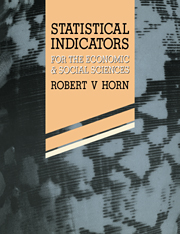Book contents
CHAPTER 6 - CONCLUSION
Published online by Cambridge University Press: 27 October 2009
Summary
Indicators help us to gain knowledge and understanding. They condense and transform information so that it can be applied to analysis and policy making. They are used in all sciences for their particular purposes. In the case of social indicators, which, broadly interpreted, have been our main subject here, their function has been described as tracing pathways through the maze of society's interconnections (Rice, 1967), or as illuminating the topography of the human landscape (L'Inguiste, 1978). Even monetary or other quantitative indicators should not stand alone as statistical abstractions but should be viewed within a human and social setting that can be described by further indication.
One major theme of this book has been reference to time: what has happened, is happening or will happen. Another has been structure: the analysis of an existing pattern and comparison with other patterns located elsewhere in time or space. A further recurring feature has been the extension of indicative measurement into an ordering function that gives indicators a role in determining and describing what is being measured.
The book has tried to avoid technical obfuscation and to demystify jargon by explaining its meaning. This applies also to the sections on techniques, which select from the general texts a few major processes that are often misapplied or mismatched in their mechanical application to indicators (e.g. averaging, weighting, scaling).
The sections on application represent no more than part of the larger repertory of economic and social types.
- Type
- Chapter
- Information
- Statistical IndicatorsFor the Economic and Social Sciences, pp. 206 - 207Publisher: Cambridge University PressPrint publication year: 1993



